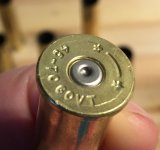jonnefudge
New member
Hi,
From what I understand you should not load the marlin 1895 45-70 with higher pressures than 40000 psi. Is it around this limit you start to see pressure signs on the brass? Or could you exceed the limit to dangerous pressures without first getting pressure signs? Is this different with different cartridges?
I am currently loading 51gr Norma 200, 340gr lead cast and LR primer with no pressure signs on the primers. Looks really mild (see pic). However this should not be to far from 400000psi hence the question.
/jonne
From what I understand you should not load the marlin 1895 45-70 with higher pressures than 40000 psi. Is it around this limit you start to see pressure signs on the brass? Or could you exceed the limit to dangerous pressures without first getting pressure signs? Is this different with different cartridges?
I am currently loading 51gr Norma 200, 340gr lead cast and LR primer with no pressure signs on the primers. Looks really mild (see pic). However this should not be to far from 400000psi hence the question.
/jonne

